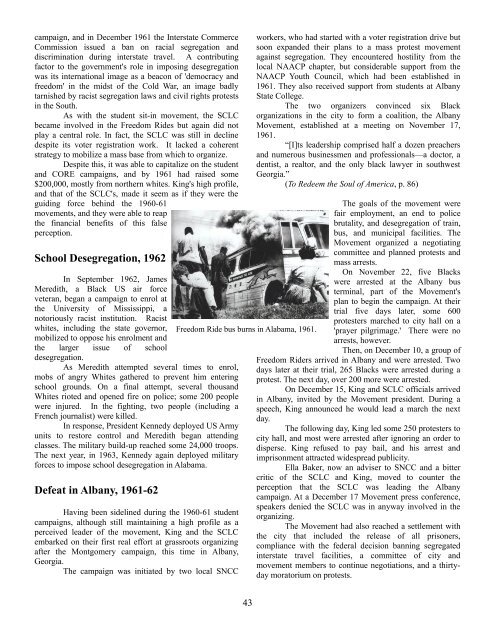smash-pacifism-zine
smash-pacifism-zine
smash-pacifism-zine
Create successful ePaper yourself
Turn your PDF publications into a flip-book with our unique Google optimized e-Paper software.
campaign, and in December 1961 the Interstate Commerce<br />
Commission issued a ban on racial segregation and<br />
discrimination during interstate travel. A contributing<br />
factor to the government's role in imposing desegregation<br />
was its international image as a beacon of 'democracy and<br />
freedom' in the midst of the Cold War, an image badly<br />
tarnished by racist segregation laws and civil rights protests<br />
in the South.<br />
As with the student sit-in movement, the SCLC<br />
became involved in the Freedom Rides but again did not<br />
play a central role. In fact, the SCLC was still in decline<br />
despite its voter registration work. It lacked a coherent<br />
strategy to mobilize a mass base from which to organize.<br />
Despite this, it was able to capitalize on the student<br />
and CORE campaigns, and by 1961 had raised some<br />
$200,000, mostly from northern whites. King's high profile,<br />
and that of the SCLC's, made it seem as if they were the<br />
guiding force behind the 1960-61<br />
movements, and they were able to reap<br />
the financial benefits of this false<br />
perception.<br />
School Desegregation, 1962<br />
In September 1962, James<br />
Meredith, a Black US air force<br />
veteran, began a campaign to enrol at<br />
the University of Mississippi, a<br />
notoriously racist institution. Racist<br />
whites, including the state governor,<br />
mobilized to oppose his enrolment and<br />
the larger issue of school<br />
desegregation.<br />
As Meredith attempted several times to enrol,<br />
mobs of angry Whites gathered to prevent him entering<br />
school grounds. On a final attempt, several thousand<br />
Whites rioted and opened fire on police; some 200 people<br />
were injured. In the fighting, two people (including a<br />
French journalist) were killed.<br />
In response, President Kennedy deployed US Army<br />
units to restore control and Meredith began attending<br />
classes. The military build-up reached some 24,000 troops.<br />
The next year, in 1963, Kennedy again deployed military<br />
forces to impose school desegregation in Alabama.<br />
Defeat in Albany, 1961-62<br />
Having been sidelined during the 1960-61 student<br />
campaigns, although still maintaining a high profile as a<br />
perceived leader of the movement, King and the SCLC<br />
embarked on their first real effort at grassroots organizing<br />
after the Montgomery campaign, this time in Albany,<br />
Georgia.<br />
The campaign was initiated by two local SNCC<br />
Freedom Ride bus burns in Alabama, 1961.<br />
workers, who had started with a voter registration drive but<br />
soon expanded their plans to a mass protest movement<br />
against segregation. They encountered hostility from the<br />
local NAACP chapter, but considerable support from the<br />
NAACP Youth Council, which had been established in<br />
1961. They also received support from students at Albany<br />
State College.<br />
The two organizers convinced six Black<br />
organizations in the city to form a coalition, the Albany<br />
Movement, established at a meeting on November 17,<br />
1961.<br />
“[I]ts leadership comprised half a dozen preachers<br />
and numerous businessmen and professionals—a doctor, a<br />
dentist, a realtor, and the only black lawyer in southwest<br />
Georgia.”<br />
(To Redeem the Soul of America, p. 86)<br />
The goals of the movement were<br />
fair employment, an end to police<br />
brutality, and desegregation of train,<br />
bus, and municipal facilities. The<br />
Movement organized a negotiating<br />
committee and planned protests and<br />
mass arrests.<br />
On November 22, five Blacks<br />
were arrested at the Albany bus<br />
terminal, part of the Movement's<br />
plan to begin the campaign. At their<br />
trial five days later, some 600<br />
protesters marched to city hall on a<br />
'prayer pilgrimage.' There were no<br />
arrests, however.<br />
Then, on December 10, a group of<br />
Freedom Riders arrived in Albany and were arrested. Two<br />
days later at their trial, 265 Blacks were arrested during a<br />
protest. The next day, over 200 more were arrested.<br />
On December 15, King and SCLC officials arrived<br />
in Albany, invited by the Movement president. During a<br />
speech, King announced he would lead a march the next<br />
day.<br />
The following day, King led some 250 protesters to<br />
city hall, and most were arrested after ignoring an order to<br />
disperse. King refused to pay bail, and his arrest and<br />
imprisonment attracted widespread publicity.<br />
Ella Baker, now an adviser to SNCC and a bitter<br />
critic of the SCLC and King, moved to counter the<br />
perception that the SCLC was leading the Albany<br />
campaign. At a December 17 Movement press conference,<br />
speakers denied the SCLC was in anyway involved in the<br />
organizing.<br />
The Movement had also reached a settlement with<br />
the city that included the release of all prisoners,<br />
compliance with the federal decision banning segregated<br />
interstate travel facilities, a committee of city and<br />
movement members to continue negotiations, and a thirtyday<br />
moratorium on protests.<br />
43



